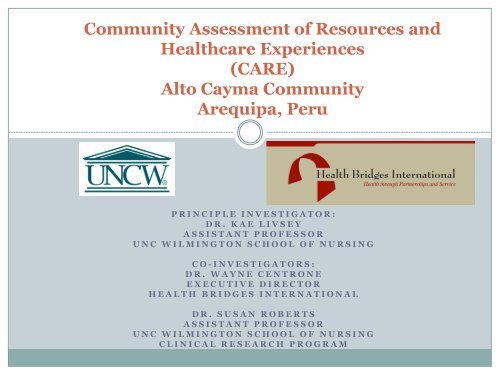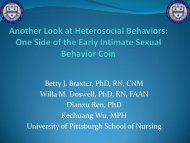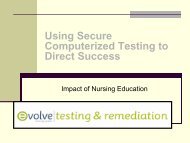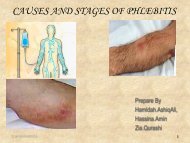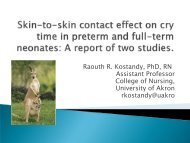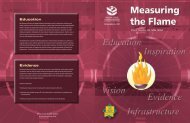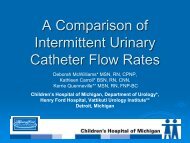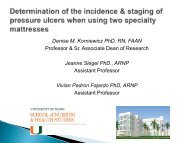Community Assessment of Resources and Healthcare ... - IUPUI
Community Assessment of Resources and Healthcare ... - IUPUI
Community Assessment of Resources and Healthcare ... - IUPUI
You also want an ePaper? Increase the reach of your titles
YUMPU automatically turns print PDFs into web optimized ePapers that Google loves.
<strong>Community</strong> <strong>Assessment</strong> <strong>of</strong> <strong>Resources</strong> <strong>and</strong><br />
<strong>Healthcare</strong> Experiences<br />
(CARE)<br />
Alto Cayma <strong>Community</strong><br />
Arequipa, Peru<br />
P R I N C I P L E I N V E S T I G A T O R :<br />
D R . K A E L I V S E Y<br />
A S S I S T A N T P R O F E S S O R<br />
U N C W I L M I N G T O N S C H O O L O F N U R S I N G<br />
CO- I N V E S T I G A T O R S :<br />
D R . W A Y N E C E N T R O N E<br />
E X E C U T I V E D I R E C T O R<br />
H E A L T H B R I D G E S I N T E R N A T I O N A L<br />
D R . S U S A N R O B E R T S<br />
A S S I S T A N T P R O F E S S O R<br />
U N C W I L M I N G T O N S C H O O L O F N U R S I N G<br />
C L I N I C A L R E S E A R C H P R O G R A M
Acknowledgements<br />
This study would not have been possible without the assistance <strong>of</strong> numerous people, both here in<br />
the United States <strong>and</strong> in the community <strong>of</strong> Alto Cayma. The researchers are indebted to :<br />
Father Alex Busuttil <strong>and</strong> staff members <strong>of</strong> the Maria Madre de los Missiones clinic.<br />
Roberta Allred Dr. Jennifer Horan Clark Luikart Dr. Susan Pierce<br />
Karen Falkenstein <strong>of</strong> Health Bridges International<br />
UNCW Nursing students who assisted in data collection for the study:<br />
Am<strong>and</strong>a Bodnar<br />
Matthew Bowers<br />
Cass<strong>and</strong>ra Mindt<br />
Amber Cox<br />
Rebecca Cox<br />
Danielle Allison Cray<br />
Amy Elliott<br />
Aissel Faquir Gonzalez<br />
Kristen Grimsley<br />
Stephanie Holderman<br />
Adam Sturkey<br />
Alyssa Horne<br />
Alyson Insull<br />
Stephanie Ivey<br />
Br<strong>and</strong>i Knight<br />
Rachel Livingston<br />
Meredith Lomax<br />
Brittany Pearson<br />
Bryan Sisk<br />
Alison Watkins<br />
Elizabeth Wolfson
Background<br />
• 44.5% <strong>of</strong> the Peruvian population lives in poverty<br />
(CIA World Factbook,2009).<br />
• 60% <strong>of</strong> people in communities covered by the Census lack<br />
access to a healthcare facility (Amnesty International, 2009)<br />
• Exp<strong>and</strong>ed primary <strong>and</strong> preventive care services to<br />
impoverished <strong>and</strong> marginalized populations to improve<br />
health outcome measures are needed (Mir<strong>and</strong>a, et.al, 2008; Guanais&<br />
Macinko, 2009).<br />
• Very few studies have been conducted that evaluate the<br />
access <strong>and</strong> utilization patterns <strong>of</strong> individuals living in<br />
peri-urban squatter communities <strong>of</strong> the large cities <strong>of</strong><br />
Peru
Arequipa<br />
• 2 nd largest city in Peru – after Lima<br />
• Founded in 1540 (population @850K)<br />
• Southern Peru – 7,740 feet above sea level<br />
• 70 miles from Pacific Ocean<br />
• Andes Mountains – highl<strong>and</strong>s<br />
• “The White City” – silliar stone<br />
• Foot <strong>of</strong> snow capped volcano, Mt. Misti<br />
• Language - Spanish
Alto Cayma District<br />
• Outskirts <strong>of</strong> Arequipa<br />
• Made up <strong>of</strong> 4 parishes – each with about 25,000<br />
people<br />
• Migration down from mountains<br />
• Houses – made <strong>of</strong> stone bricks – tin ro<strong>of</strong>s -no<br />
running water or electricity<br />
• Dirt roads – no trees or plants – dusty<br />
• Dogs
Peruvian Health Care System<br />
• Five major care delivery systems:<br />
◦ military <strong>and</strong> police<br />
◦ SIS (a Medicaid-like system for low-income <strong>and</strong> vulnerable<br />
populations)<br />
◦ MINSA (Ministerio de Salud, National)<br />
◦ Private clinics<br />
◦ Es Salud 9 (social security based health care program)
About the study<br />
University-NGO Partnership<br />
• This study was jointly conducted by Health Bridges<br />
International, Inc. <strong>and</strong> faculty from the University <strong>of</strong><br />
North Carolina Wilmington School <strong>of</strong> Nursing.<br />
• Health Bridges International (HBI) is a non<br />
governmental organization based in Portl<strong>and</strong>, Oregon<br />
<strong>and</strong> has been working in Peru to create collaborative<br />
projects <strong>and</strong> support for the people <strong>of</strong> Peru for over 15-<br />
years.<br />
• Students <strong>and</strong> faculty from UNCW have been going to<br />
the Alto Cayma area for clinical <strong>and</strong> cultural immersion<br />
experiences since 2004.
Purpose <strong>of</strong> the Study<br />
• Cross-sectional descriptive survey designed to<br />
evaluate:<br />
◦ healthcare access<br />
◦ demographic <strong>and</strong> socioeconomic information on households<br />
within the community<br />
◦ patterns <strong>of</strong> healthcare utilization<br />
◦ awareness <strong>of</strong> area health clinics <strong>and</strong> government <strong>and</strong> charity<br />
resources.<br />
◦ objective <strong>and</strong> subjective barriers to healthcare
Hypotheses <strong>and</strong> Assumptions<br />
• Individuals living in the communities <strong>of</strong> Alto Cayma <strong>and</strong><br />
the surrounding metropolitan area <strong>of</strong> Arequipa, Peru do not<br />
have access to adequate primary care services.<br />
• A lack <strong>of</strong> primary health care service utilization has led to<br />
greater overall disease burden in the communities’<br />
populations when compared to a more socioeconomically<br />
affluent cohort <strong>of</strong> individuals living in Arequipa.
Hypotheses <strong>and</strong> Assumptions<br />
• <strong>Healthcare</strong> usage patterns reflects individuals’ learned<br />
behaviors, <strong>and</strong> is based on lack <strong>of</strong> knowledge <strong>of</strong> available<br />
resources <strong>and</strong> a proper underst<strong>and</strong>ing <strong>of</strong> “primary care” as<br />
a longitudinal medical model.<br />
• Poor, peri-urban squatter community populations are<br />
disproportionately uninsured.<br />
• A significant barrier to individuals seeking services is their<br />
lack <strong>of</strong> insurance <strong>and</strong> lack <strong>of</strong> knowledge regarding how to<br />
properly utilize free <strong>and</strong> low-cost healthcare options.
Study Population<br />
• Participants in the study were selected by means <strong>of</strong> a<br />
convenience sample <strong>of</strong> 800 families in the Alto Cayma<br />
<strong>Community</strong><br />
• A sample <strong>of</strong> this size would represent 10% <strong>of</strong> the<br />
population, based on an estimate <strong>of</strong> family size <strong>of</strong> four.<br />
• Participants who do not maintain a domicile residence in<br />
one <strong>of</strong> the communities <strong>of</strong> Alto Cayma, or who are under<br />
the age <strong>of</strong> eighteen were excluded from this study.
Research Questions<br />
1. What are the living conditions <strong>of</strong> the people in the Alto<br />
Cayma community, in terms <strong>of</strong> access to basic services<br />
such as water, sewage <strong>and</strong> electricity?<br />
2. Do members <strong>of</strong> the community treat their water prior to<br />
consumption?<br />
3. What is the demographic makeup <strong>of</strong> households in Alto<br />
Cayma (including size <strong>of</strong> household, income <strong>and</strong><br />
education)?<br />
4. What types <strong>of</strong> assistance (government or private) are<br />
households in Alto Cayma receiving?
Research Questions<br />
5. Where do individuals in Alto Cayma seek healthcare <strong>and</strong><br />
dental care services?<br />
6. How frequently are health <strong>and</strong> dental care services<br />
accessed by members <strong>of</strong> the Alto Cayma community?<br />
7. For what reasons do community members seek health <strong>and</strong><br />
dental services?<br />
8. What barriers exist to healthcare access <strong>and</strong> utilization in<br />
Alto Cayma?
Study Methods<br />
Recruitment Methods-Announcements about the<br />
study were made at the parish center <strong>and</strong> at various<br />
local community meetings a few weeks prior to data<br />
collection, which occurred between March 11 <strong>and</strong><br />
March 19, 2009.
Human Subject Protections<br />
Permission from the UNC Wilmington Institutional Review Board<br />
(IRB) was obtained prior to data collection for the study.<br />
• All study staff received prior training in non-leading interviewing<br />
techniques <strong>and</strong> IRB training.<br />
• An introductory information sheet was read to all potential survey<br />
participants through a Spanish language interpreter.<br />
• All survey questionnaires were conducted through a trained<br />
Spanish-English interpreter.<br />
• Written informed consent forms were provided in Spanish.<br />
• In instances where participants had literacy deficits, the informed<br />
consent was read to the participant by the interpreter.<br />
• All participants were asked whether they understood the<br />
requirements <strong>and</strong> conditions for participation in the study prior to<br />
obtaining signed informed consent.
Data Collection Methods<br />
• Data collection teams included an<br />
UNCW student, a volunteer<br />
translator/interpreter, <strong>and</strong> an HBI<br />
trained staff person.<br />
• Data collection occurred in a central<br />
location within the community.<br />
• Student data collectors read the<br />
questions in English, which were then<br />
translated verbatim by the interpreter.<br />
• Responses were obtained in Spanish <strong>and</strong><br />
translated by the interpreter.
Results<br />
Sample- N=455 households<br />
Average number <strong>of</strong> members in each household:<br />
4.64 (SD=1.782, range 1-11)<br />
• Adults- 2.52 (SD= 1.172, range 1-8)<br />
• Children 2.12 (SD= 1.385, range 0-8)<br />
• Only 10% <strong>of</strong> households had no children<br />
• 91.2% reported speaking Spanish as the primary<br />
language used in the home
Access to Basic Services<br />
• 92% <strong>of</strong> households reported having electricity in the<br />
home.<br />
• 43.5% <strong>of</strong> households report having water access in<br />
the home<br />
• Approximately 31% <strong>of</strong> households have access to<br />
public water for five-hours per day or less<br />
• 84% report getting water from public spigot
Water Treatment<br />
• Public water sources are not treated, however 96.7% <strong>of</strong> respondents<br />
indicated that they treat water prior to consumption<br />
Method <strong>of</strong> Water<br />
Treatment<br />
Boil<br />
Filter<br />
Bleach<br />
Boil/Bleach<br />
Unknown/Not<br />
Reported/Does not<br />
Treat<br />
Total<br />
N<br />
Percentage<br />
386<br />
84.8%<br />
48<br />
10.5%<br />
3<br />
0.7%<br />
1<br />
0.2%<br />
17<br />
3.7%<br />
455 100%
Household Income<br />
• Average number workers in the home 1.4<br />
(SD= .677, range 0-4).<br />
• Households averaged 0 to 28 hours per week worked (mean 7.2<br />
hours per week per family)<br />
• Average reported income per day was 28.46 Peruvian Soles or<br />
less than $10USD per day worked<br />
• Monthly household income estimates indicate that members <strong>of</strong><br />
this community are living just above the World Bank defined<br />
poverty level ($150USD/month for a family <strong>of</strong> four).
Educational Attainment<br />
Less than half <strong>of</strong> adults in household have education<br />
beyond primary level.<br />
Fathers<br />
Mothers<br />
Nine percent <strong>of</strong> households reported that parents had never attended school,<br />
with mothers being almost three times as likely as fathers <strong>of</strong> having<br />
had no formal education
Sponsorship/Assistance<br />
• Less than half (48.7%)<br />
<strong>of</strong> respondents<br />
indicated that<br />
children in the home<br />
were receiving<br />
sponsorship from<br />
either a governmental<br />
or private charitable<br />
organization.<br />
Type <strong>of</strong> Sponsorship Program<br />
Christian Foundation for Children <strong>and</strong> Aging<br />
Vasode Leche<br />
Acerc<strong>and</strong>enos<br />
Grupo Arcano<br />
Prona<br />
Unknown/Not Reported<br />
5% 0% 1% 3%<br />
37%<br />
54%
Government Support for <strong>Healthcare</strong><br />
• Given the average reported income by households<br />
surveyed in this study, many <strong>of</strong> the households<br />
would be eligible for SIS program services.<br />
• Most respondents (73.4%) were aware <strong>of</strong> the<br />
government SIS program, however only 13.6% <strong>of</strong> the<br />
respondents <strong>and</strong> 47.4% <strong>of</strong> the children in the<br />
household reportedly received benefits from the SIS<br />
program.
<strong>Healthcare</strong> Utilization<br />
32% <strong>of</strong> adults reported<br />
that they a health care<br />
provider 2-3x per year
Type <strong>of</strong> clinics used<br />
Adults<br />
Children<br />
Type <strong>of</strong> Clinic N % N %<br />
MINSA 194 42.6% 212 51.8%<br />
Private Clinic 164 36.0% 147 35.9%<br />
Es Salud 28 6.2% 26 6.4%<br />
Not Reported 27 5.9% 8 2.0%<br />
Other 23 5.1% 9 2.2%<br />
None/doesn't<br />
go 19 4.2% 7 1.7%<br />
Total 455 100.0% 409 100.0%
Reasons for <strong>Healthcare</strong> Visits<br />
• Most common ailments being upper respiratory<br />
conditions (24%)<br />
(cold, cough, sore throat, bronchitis or flu)<br />
• Gastrointestinal symptoms (17.1%)<br />
(gastritis, stomach ache/infection, nausea/vomiting).
Dental Care Utilization-Adults<br />
• 53.0% <strong>of</strong> respondents indicated that they received<br />
dental care<br />
• 36.1% indicated that they only sought dental care<br />
when issues arise, such as a visible cavity.<br />
• Only 3.7% <strong>of</strong> respondents indicated that they had<br />
visited the dentist for preventative services, such as<br />
cleaning or a checkup.
Dental Care Utilization-Children<br />
• 54.5% <strong>of</strong> children in the communities surveyed<br />
receive dental care services.<br />
• 39.0% <strong>of</strong> children accessed dental care services 2-3<br />
times per year, compared to 26.6% <strong>of</strong> adult<br />
respondents.<br />
• Some respondents that children accessed dental<br />
services through school programs.
Emergency Care<br />
Frequency<br />
Percent<br />
Do you know where to receive urgent or emergent medical care<br />
if you are involved in an accident or injury?<br />
Unknown/Not Reported 5 1.1<br />
No 56 12.3<br />
Yes 394 86.6<br />
Total 455 100
Table 15. Prescription Access<br />
Prescription Access<br />
Frequency<br />
Percent<br />
Able to afford to fill prescription<br />
No 305 67.0%<br />
Yes 147 32.3%<br />
Not Reported 3 0.7%<br />
Total 455 100%
Barriers to Care<br />
Reasons for not accessing healthcare services<br />
Money 295 80.4%<br />
Money <strong>and</strong> Transportation 11 3.0%<br />
Transportation 11 3.0%<br />
Lack <strong>of</strong> trust/unfavorable<br />
experience 10 2.7%<br />
Childcare/eldercare 8 2.2%<br />
Time 6 1.6%<br />
Money <strong>and</strong> child/elder care 4 1.1%<br />
Money, lack <strong>of</strong> trust/unfavorable<br />
experience 4 1.1%<br />
Don't know where to go 1 0.3%<br />
Job 1 0.3%<br />
Physical limitations 1 0.3%<br />
Uses pharmacy or tolerates pain 1 0.3%<br />
Not Reported 14 3.8%
Study Limitations<br />
• Convenience sampling<br />
• Limited sample size<br />
• Measurement error, since an interpreter was used to<br />
administer the survey.<br />
• Culturally different conceptualizations <strong>of</strong> health,<br />
health seeking behaviors <strong>and</strong> health care utilization.<br />
• These findings cannot be generalized to other<br />
communities within Arequipa or other areas <strong>of</strong> Peru.
Discussion<br />
• Findings from this study indicate a need for<br />
additional access to basic public health services such<br />
as clean water <strong>and</strong> sewer, as well as primary health<br />
care <strong>and</strong> dental services for individuals living the<br />
Alto Cayma <strong>Community</strong>.<br />
• Barriers to healthcare are evident, primarily related<br />
to poverty <strong>and</strong> lack <strong>of</strong> income. Other barriers to be<br />
further explored include transportation needs, <strong>and</strong><br />
lack <strong>of</strong> knowledge about available support programs<br />
<strong>and</strong> services.
Discussion<br />
• Other challenges in the area include lack <strong>of</strong><br />
education among adults, <strong>and</strong> presence <strong>of</strong> unstable<br />
<strong>and</strong> low wage employment.<br />
• Services to improve educational opportunities <strong>and</strong><br />
job training would be beneficial in this community,<br />
especially for adult women.
Suggestions for additional research<br />
• More information is needed as to whether current<br />
healthcare programs in the area are functioning at<br />
maximum capacity <strong>and</strong> what resources for these<br />
programs may be needed.<br />
• Future studies should further explore the presence <strong>of</strong><br />
other barriers to healthcare access, especially related<br />
to health seeking behaviors, <strong>and</strong> whether issues <strong>of</strong><br />
trust are also a barrier to seeking care.
Lessons Learned<br />
• Pilot your instrument before embarking on large<br />
scale study<br />
• Informed consent procedures in this population<br />
group
Questions?<br />
Thank you!<br />
Kae Rivers Livsey RN, MPH, PhD<br />
University <strong>of</strong> North Carolina Wilmington<br />
School <strong>of</strong> Nursing<br />
livseyk@uncw.edu


